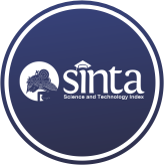Identifikasi Pengaruh Kualitas Udara Terhadap Pasien Covid-19 dengan Algoritma Naïve Bayes, K-NN dan SVM (Kasus Kota Jakarta dan Singapura)
(1) Universitas Kristen Satya Wacana, Indonesia
(2) Universitas Kristen Satya Wacana, Indonesia
(*) Corresponding Author
Abstract
Full Text:
PDFReferences
World Health Organization, “WHO Coronavirus Disease (COVID-19) Dashboard,” https://www.who.int/emergencies/diseases/novel. [Online]. Available: https://www.who.int/emergencies/diseases/novel
C. Sohrabi et al., “World Health Organization declares global emergency: A review of the 2019 novel coronavirus (COVID-19),” Int. J. Surg., vol. 76, pp. 71–76, 2020, doi: https://doi.org/10.1016/j.ijsu.2020.02.034.
L. Qun et al., “Early Transmission Dynamics in Wuhan, China, of Novel Coronavirus–Infected Pneumonia,” N. Engl. J. Med., vol. 382, no. 13, pp. 1199–1207, Mar. 2020, doi: 10.1056/NEJMoa2001316.
J. Bin Tan, M. J. Cook, P. Logan, L. Rozanova, and A. Wilder-Smith, “Singapore’s Pandemic Preparedness: An Overview of the First Wave of COVID-19.,” Int. J. Environ. Res. Public Health, vol. 18, no. 1, Dec. 2020, doi: 10.3390/ijerph18010252.
C. I. Agency, “The World Factbook: Indonesia.” [Online]. Available: https://www.cia.gov/the-world-factbook/
M. Borro et al., “Evidence-based considerations exploring relations between sars-cov-2 pandemic and air pollution: Involvement of pm2.5-mediated up-regulation of the viral receptor ace-2,” Int. J. Environ. Res. Public Health, vol. 17, no. 15, pp. 1–13, 2020, doi: 10.3390/ijerph17155573.
S. Comunian, D. Dongo, C. Milani, and P. Palestini, “Air pollution and covid-19: The role of particulate matter in the spread and increase of covid-19’s morbidity and mortality,” Int. J. Environ. Res. Public Health, vol. 17, no. 12, pp. 1–22, 2020, doi: 10.3390/ijerph17124487.
A.-C. Pinho-Gomes et al., “Air pollution and climate change,” Lancet Planet. Heal., vol. 7, no. 9, pp. e727–e728, Sep. 2023, doi: 10.1016/S2542-5196(23)00189-4.
C. Copat et al., “The role of air pollution (PM and NO(2)) in COVID-19 spread and lethality: A systematic review.,” Environ. Res., vol. 191, p. 110129, Dec. 2020, doi: 10.1016/j.envres.2020.110129.
X. Wu, R. C. Nethery, M. B. Sabath, D. Braun, and F. Dominici, “Air pollution and COVID-19 mortality in the United States: Strengths and limitations of an ecological regression analysis,” Sci. Adv., vol. 6, no. 45, p. eabd4049, Sep. 2024, doi: 10.1126/sciadv.abd4049.
B. T. P. Briandy, E. Yulianingsih, Fatmasari, and Ferdiansyah, “Analisis Tingkat Akurasi Prediksi Gejala COVID - 19 Dengan Menggunakan Metode Logistic Regression dan Support Vector Machine,” J. Fasilkom, vol. 13, no. 02, pp. 269–278, 2023, doi: 10.37859/jf.v13i02.5629.
D. Y. Liliana, H. Maulana, and A. Setiawan, “Data Mining untuk Prediksi Status Pasien Covid-19 dengan Pengklasifikasi Naïve Bayes,” Multinetics, vol. 7, no. 1, pp. 48–53, 2021, doi: 10.32722/multinetics.v7i1.3786.
A. I. Sang, E. Sutoyo, and I. Darmawan, “Analisis Data Mining Untuk Klasifikasi Data Kualitas Udara Dki Jakarta Menggunakan Algoritma Decision Tree Dan Support Vector Machine Data Minning Analysis for Classification of Air Quality Data Dki Jakarta Using Decision Tree Algorthm and Support Vector ,” e-Proceeding Eng., vol. 8, no. 5, pp. 8954–8963, 2021.
Y. Ogen, “Assessing nitrogen dioxide (NO2) levels as a contributing factor to coronavirus (COVID-19) fatality,” Sci. Total Environ., vol. 726, p. 138605, 2020, doi: https://doi.org/10.1016/j.scitotenv.2020.138605.
DOI: https://doi.org/10.30645/kesatria.v6i1.540
DOI (PDF): https://doi.org/10.30645/kesatria.v6i1.540.g535
Refbacks
- There are currently no refbacks.
Published Papers Indexed/Abstracted By:














